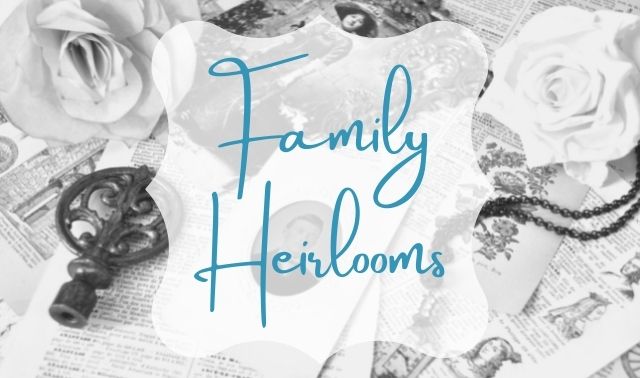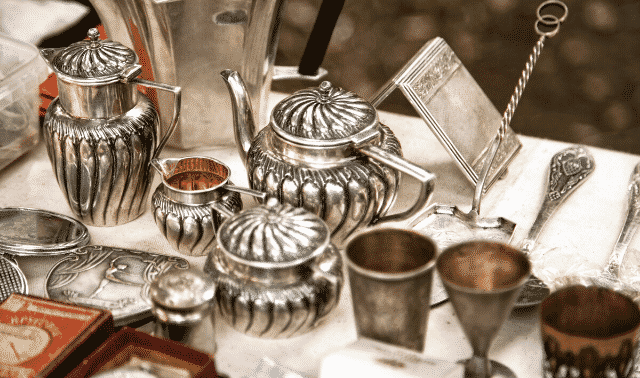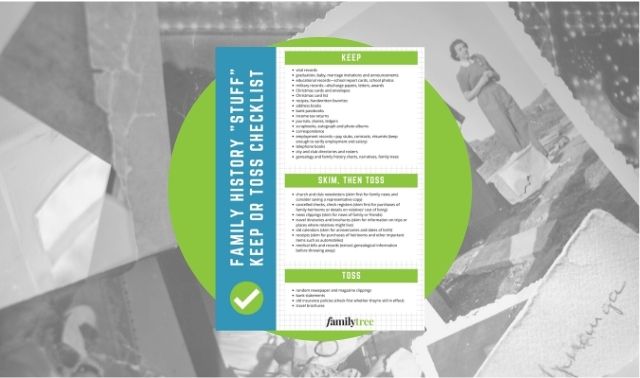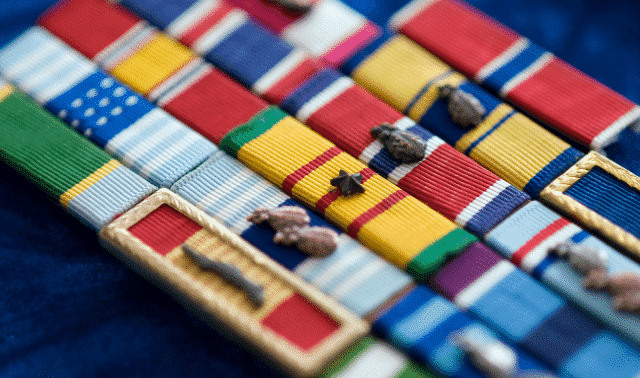Sign up for the Family Tree Newsletter Plus, you’ll receive our 10 Essential Genealogy Research Forms PDF as a special thank you!
Get Your Free Genealogy Forms
"*" indicates required fields
When my in-laws passed away, we were left with the contents of the home they lived in for 50 years. The basement held boxes still unopened from their move into the house; upstairs were cancelled checks from their entire married life.
The sheer volume of stuff was overwhelming. But it was also a great opportunity to learn more about my husband’s parents and their parents. Once we started to think about the estate as a family collection, how could we part with anything?
Family historians face internal conflicts when tasked with sorting an entire lifetime’s worth of inherited belongings. We’re eager to tackle the mountain as quickly as possible—it’s tempting to select items we want to keep and get rid of what’s left. On the other hand, we’re wary of discarding clues to our ancestors’ lives. Is anything really trash? If we could, we’d keep every family-related item, carefully examine it and store it.
Try to approach your inherited items with the eyes of an archivist. Just as an archivist understands that not everything merits the time and expense of being cataloged, indexed and stored, a family historian must understand that not every inherited item is worth holding on to. Some items are discarded, others donated and still others marked for preservation.
We’ll help you determine what to keep, and how to pass on what you don’t.
Sorting Heirlooms Among Relatives
If the estate has more than one heir, you’ll want to reach agreements with the other heirs on an equitable arrangement for distributing property, cash and major household items. To a family historian, that amateurish portrait of Grandpa Ron at age 18 might be much more valuable than the hand-carved Windsor chair from the parlor. Grandma Sue’s hand-stitched sampler might be worth more to you than her set of Limoges china.
Heirlooms, the sentimental bits and pieces, and the genealogical paper treasures can be difficult to distribute. Decide among family whether to:
- divide family history materials equally among relatives
- keep scrapbooks, photo albums, letters and the like together in one person’s care
- donate as much as possible to a local genealogical or historical society
- sell, give away or discard what remains
You may find that your relatives agree to a combination of all options. Some families choose to distribute heirlooms in the same way they share major household items—each person chooses a number and makes a selection. Or some degree of negotiating might take place: One person takes Great-grandpa’s pocket watch; another gets his shaving mug and brush.
Differences in monetary value can complicate things (a chipped shaving mug has less monetary value than a gold pocket watch), so it helps if everyone can agree to a few basic guidelines. For example, you might pass down heirlooms along blood lines, or give extra consideration to namesakes and godchildren. If possible, let the task of distributing heirlooms wait until the nuts and bolts of the household are settled and everyone has time to share thoughts about those sentimental family items.
If you have limited time to distribute an estate, consider naming a family historian to store miscellaneous records, papers and photos. Ask the historian to keep track of who inherits heirlooms using our heirloom inventory forms and provide each family member with a copy. Your family historian also might offer to make copies of photographs for each person who wants them.
Trash or Treasure?
Genealogists look for information that will identify ancestors and confirm theories about their lives. We also seek personal anecdotes and small details that bring relatives to life. Much of this information is in documents, photographs, letters and sometimes in artifacts. Before you rent a dumpster or hire an estate sale agent, pause and examine your inheritance for genealogical clues.
If you’re the family historian, make it your job to sift and save important items along the paper trail. Our guide (linked to below) provides some suggestions for paper items, specifically.
When dealing with other heirlooms, you may find it helpful to employ a “collections policy.” Years of experience with family collections have helped historical societies develop collections policies to guide new acquisitions. Some organizations, such as the Museum of History in Pasadena, Calif., have formed collections committees to regularly review potential donations. Laura Verlaque, the museum’s director of collections, says the committee evaluates materials according to four questions. Adapt them to fit your own circumstances:
- Does this item further our mission?
- Do we have funds available to care for the item?
- Do we have sufficient storage space?
- Does this duplicate an item already in our collection?
How to Successfully Donate Heirlooms
If your family decides to donate antiques, papers or photographs to a historical society, you may be surprised to discover that such a gift must be approved and accepted. Donations may be politely declined if they don’t fit the society’s collections policy.
“First and foremost, we look for items related to our town. Things that were made in our city, such as pottery, are most welcome, but we are also interested in unique items used here,” Verlaque says. As you look for a new home for your inheritances, consider the following:
- Do you have a record of provenance for the item, or know how it came into your family? If an item is valued for its connection to an owner, you’ll need proof of this relationship, such as a letter, sales slip or photograph.
- Why is this item worthy of preservation? An antique clock can be worth money, but if it’s a fairly common design, it may not interest your historical society. A clock that once sat on the mayor’s desk, however, may be a welcomed contribution.
- What was the owner’s position in the community? If your relative was the town’s first mayor, a local historical society will be much more interested in your items than if he was an average resident. On the other hand, if this average resident was an active volunteer, perhaps the organization where he volunteered could suggest an appreciative home for your donation.
Your family doesn’t have to be rich or famous for your artifacts to be interesting, but you can take steps to make them more attractive to a potential recipient. Consider a variety of organizations, and review their missions and collections policies. Aim to make your contributions a good fit. Look beyond your local town museum to consider county, state, regional or national historical societies or museums; military, organizational and occupational museums; churches; clubs; and schools. The library where your dad enjoyed reading to preschoolers, for example, might want his piano for the community room, or it might be happy to sell the instrument and use the funds to purchase books in his memory.
When proposing a donation to an organization, follow Verlaque’s suggestions:
- Write a brief description of the item, including dimensions. Be honest about its condition; note where it’s been stored and if it’s been well-cared for or become slightly damaged. If parts have been replaced or restored, make note of it.
- Explain anything you know about where it came from and how it came into your family. This statement of provenance is essential in establishing historical value.
- Include a photograph. Place the item in good natural light and snap several photos. (Read more photo-taking tips.) Include the best image with your description.
- Be prepared to wait. Many museums are staffed by volunteers who evaluate donation proposals only periodically.
As a donor, you may be asked to have items appraised for tax purposes, and sign release forms transferring ownership and rights to the museum. Most institutions also welcome a donation of funds to offset the cost of caring for your gift.
You might have been gifted with one box of family treasures or an entire houseful of stuff, but your family inheritance can be thoughtfully winnowed to a manageable size—and the heirs left confident that they respectfully cared for the estate. By thinking like an archivist and following these guidelines, you’ll preserve the treasures, extract important family history information, and thoughtfully dispose of the chaff.
TIP: Make sure any heirlooms that stay in the family are properly cared for. Relatives can find archival storage materials at suppliers such as Archival Methods, Gaylord Brothers, Light Impressions and University Products.
Related Reads
A version of this article appeared in the January 2011 issue of Family Tree Magazine.
ADVERTISEMENT










